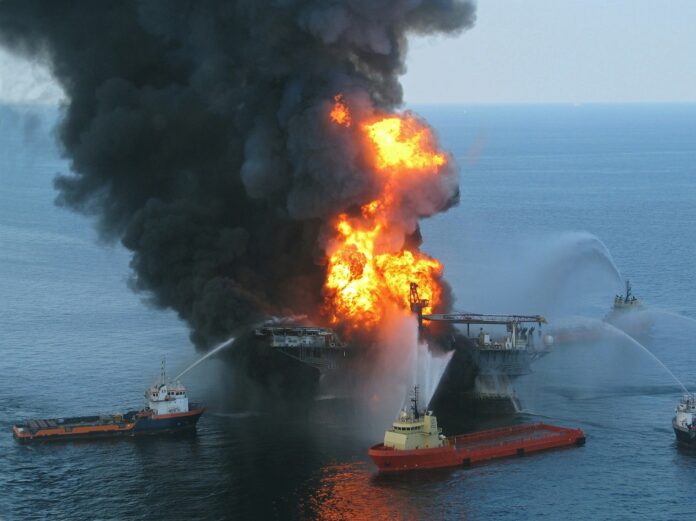MONTGOMERY, Ala. – Monday, Governor Kay Ivey commemorated the passing of 10 years since the Deepwater Horizon oil spill. On April 20, 2010, the Deepwater Horizon oil rig exploded in the Gulf of Mexico, leading to the largest marine oil spill in American history and the death of 11 men.
“As we remember this tragic event, we recognize the human cost of the oil spill and remember those whose loved ones were lost or injured in the incident and those that were affected in coastal Alabama,” Ivey said. “We will never forget how we felt during those troubled times and how greatly our coastal communities were impacted. Since the events of that tragic day, Alabama, the other Gulf states and our federal partners have worked diligently to repair the ecological, environmental and economic damages that were inflicted in the Gulf of Mexico and along the shorelines of our Gulf Coast states. That work continues today and will continue for years to come.”
Alabama will receive more than $1.4 billion through 2032 from the various funding sources established after the Deepwater Horizon oil spill to conduct restoration projects in the state. The restoration work is coordinated and administered by the Alabama Department of Conservation and Natural Resources (ADCNR).
“In the first decade since the spill, we have made significant progress restoring and protecting the resources and coastal areas of Alabama,” said Christopher M. Blankenship, ADCNR commissioner. “Almost 160 projects have been approved, are underway or have been completed to restore, conserve or protect the various natural and economic resources of Alabama. The combined estimated cost of these projects is more than $790 million. These projects are making quite a positive impact on the state’s coastal recovery. I look forward to continuing these efforts in Alabama.”
These projects further Alabama’s restoration goals of replenishing and protecting living coastal and marine resources; supporting and enhancing community resilience; providing and enhancing economic development and infrastructure; restoring, conserving, and enhancing habitat; providing and enhancing recreation and public access; restoring water quality; providing planning support; and conducting science, research, and monitoring.
“Restoration is not a quick or easy process,” Ivey said. “Alabama and our partners have heard from the public, we have worked with local governments, non-governmental agencies, businesses and others to do good work. Through comprehensive planning, careful design, successful implementation, and robust monitoring, we are confident that our resources are being protected and restored.
“In true Alabama fashion, we have worked together diligently to make our state better than it was before the tragedies of April 20, 2010. We are proud of the way Alabama and our partners have responded since those dark days and appreciate the efforts of the Alabama Department of Conservation and Natural Resources to coordinate and administer quality restoration efforts now and into the future. We are committed to restoring the natural resources of Alabama, no matter how long it takes.”
Restoration funding for projects in Alabama is provided through the following: the Natural Resource Damage Assessment (NRDA), the National Fish and Wildlife Foundation’s Gulf Environmental Benefit Fund (GEFB), and two councils established by the RESTORE Act, the Alabama Gulf Coast Recovery Council and the Gulf Coast Ecosystem Restoration Council.
Natural Resource Damage Assessment
Alabama’s NRDA trustees (ADCNR and the Geologic Survey of Alabama) work with trustees from the other Gulf Coast states and four federal agencies on NRDA restoration plans. Those restoration plans also address recreational use, water quality, living coastal and marine resources, wetlands, and coastal and nearshore habitats.
National Fish and Wildlife Foundation
The National Fish and Wildlife Foundation coordinates restoration project activities with the conservation and natural resources agencies in the five Gulf Coast states. These projects are funded by criminal fines resulting from the oil spill.
Alabama Gulf Coast Recovery Council
Chaired by Governor Ivey and vice-chaired by Alabama State Docks Director Jimmy Lyons, the council is responsible for selecting projects to be funded from the Direct Component and Spill Impact Component of the Gulf Coast Restoration Trust Fund. Projects selected for funding are administered by ADCNR’s Deepwater Horizon Restoration Section.
Gulf Coast Ecosystem Restoration Council
ADCNR Commissioner Blankenship represents Alabama on the Gulf Coast Ecosystem Restoration Council. He works with representatives from the other Gulf Coast states and six federal agencies to develop projects that are funded through the Council-selected Restoration Component of the Gulf Coast Restoration Trust Fund.
RESTORE Act
The federal RESTORE Act dedicates 80 percent of all administrative and civil penalties related to the Deepwater Horizon spill to a Gulf Coast Restoration Trust Fund and outlines a structure by which the funds can be utilized to restore and protect the natural resources, ecosystems, fisheries, marine and wildlife habitats, beaches, coastal wetlands, and economy of the Gulf Coast region.
For more information on coastal restoration projects in Alabama from all Deepwater Horizon funding sources, please visit www.alabamacoastalrestoration.org.




















